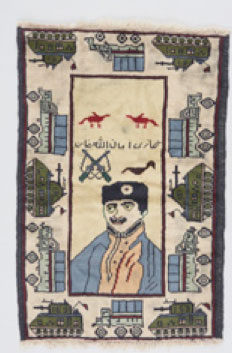"Battleground: War Rugs from Afghanistan" at Penn Museum April 30 through July 31 |
|
April 26, 2011,
Volume 57, No. 31
|
 |
This rug depicts Amanullah Khan and the words: Ghazi (king) Amanullah Khan. Amanullah Khan (1892-1960) was the king of Afghanistan from 1919-1929. He wrote the country’s first constitution, defining the role of the monarch and emphasizing equal rights and individual freedoms. Made in Afghanistan, 1980-2007, 85 x 58 cm. |
Battleground: War Rugs from Afghanistan, a traveling exhibition organized by the Textile Museum of Canada, makes its United States debut at the Penn Museum, where it will be on display beginning Saturday, April 30 at 1 p.m., through July 31, 2011.
Dr. Brian Spooner, curator, Near East Section of the Penn Museum and an anthropologist who specializes in Afghanistan and Oriental rugs, offers an opening day introductory lecture, following an official ribbon-cutting ceremony for the exhibition, and the reopening of Iraq’s Ancient Past: Rediscovering Ur’s Royal Cemetery, at 1 p.m.
At 3 p.m. is a film screening of Painted Trucks, (1971). Afghanistan has been in a near constant state of war for centuries, and war has become a feature of material culture. Judith and Stanley Hallett visited the country as Fulbright scholars in 1971-72, during peacetime, and made a film about the beautiful truck decorating tradition of Afghanistan (also seen in Pakistan), while riding on a truck with their crew from Kabul to Bamiyan. The viewer will also glimpse the famous Bamiyan Buddha sculptures as they looked before they were destroyed by the Taliban. The filmmakers note that this film has become a cult favorite in the Afghani community which has grown nostalgic for their country in the best of times. The filmmakers will be present at the screening to answer questions about the film.
Afghan rug weavers, instead of using their traditional tribal designs, depict on their rugs the world that they see. Modern warfare came to Afghanistan with the Soviet invasion of 1979. After the Soviet withdrawal in 1989, a decade of civil war was followed by the global war on terrorism. During the more than three decades of international and internal conflict that continue today, the people of Afghanistan have borne witness to the disasters of war by weaving unprecedented images of battle and weaponry into their rugs. Flowers have turned into bullets, landmines, and hand grenades. Birds have turned into helicopters and fighter jets. Sheep and horses have turned into tanks. These are the images on a new and electrifying kind of Oriental rug—the “war rugs” from Afghanistan.
The exhibition features more than 60 “war rugs”—most woven since 1980. Some of the rugs are known to be the work of weavers in refugee camps (there are four million Afghan refugees, the largest refugee population in the world), but little is known of the weavers themselves, or even of the sentiment of the rugs.
Are the rugs pro-war or anti-war? It is difficult to tell what a rug is supposed to mean when its history is hidden and its maker unknown. In the past, the materials and weaving techniques of an Oriental rug were a clue to its origin. People of different ethnic groups, in different places, made rugs in different ways. Today people from all over Afghanistan, meeting together in refugee camps, share and mix images and techniques. As a result, the old methods of sorting rugs into categories no longer apply. The rugs speak for themselves-eloquent anonymous documents about life in an ancient land wracked by near-constant war.
Admission to Battleground: War Rugs from Afghanistan is free with regular Museum admission donation, and free for active US military and their families (with ID).
Battleground: War Rugs from Afghanistan, curated by Max Allen, first opened at the Textile Museum of Canada, in Toronto, in April 2008.
The presentation of Battleground: War Rugs from Afghanistan at the Penn Museum is made possible by the generosity of ARZU STUDIO HOPE, Connie K. Duckworth, founder and CEO, and an anonymous donor. The exhibition opens in the back gallery of the newly refurbished and air-conditioned second floor west wing, concurrently with the reopening of the long-term exhibition Iraq’s Ancient Past: Rediscovering Ur’s Royal Cemetery.
Related: "Iraq's Ancient Past" Reopens Following Gallery Renovations at Penn Museum April 30 |